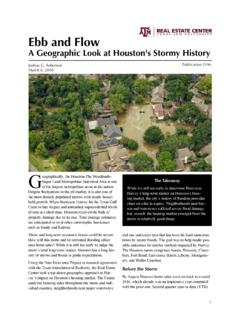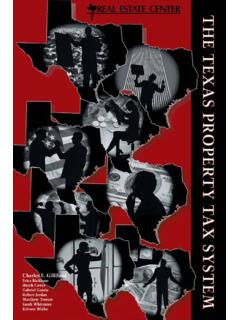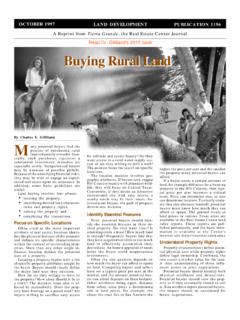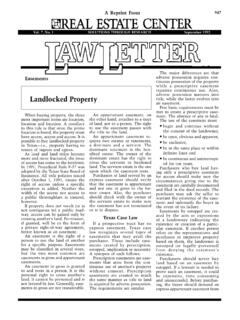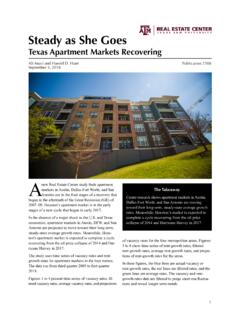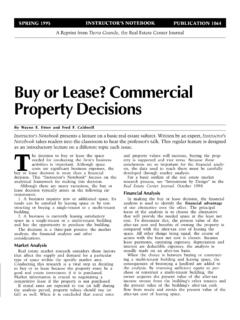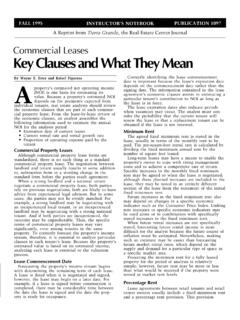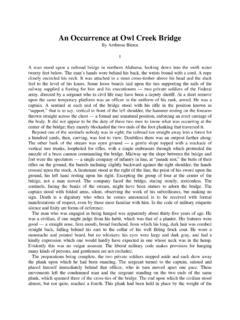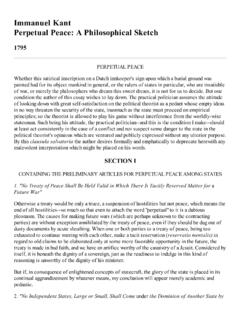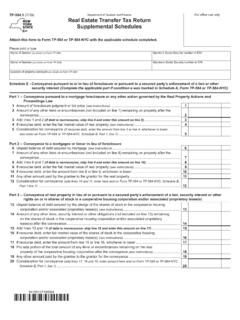Transcription of Minerals, Surface Rights and Royalty Payments
1 Judon Fambrough Senior Lecturer and Attorney at LawMinerals, Surface Rights and Royalty PaymentsTexas A&M UniversityRevised November 2009 2009, Real Estate Center. All Rights ..1 Surface Rights and mineral Rights ..1 mineral Agreements Grant Ownership Rights ..1 Exceptions to the Rule on Surface Use ..1 Court Cases Resolve Conflicts ..2 Minerals: Not All Substances in Ground ..2 Other Surface Protection Measures ..3 Negotiating Terms of mineral Exploration ..3 Exploration Techniques ..3 Permission for Exploration ..4 Liability for Geophysical Trespass ..4 Geophysical Explorations Under Lease ..4 Lease Considerations ..4 Taxation of Payments ..5 Division Orders and Royalty Checks ..5 Division Orders ..5 Royalty Checks ..7 mineral Owners' Options ..71 SummaryThe exploration and production of minerals, especially oil and gas, have played an important role in the eco-nomic development of Texas. Because most of the oil and gas is privately owned, a body of law has evolved in the state that defines ownership Rights .
2 One of the earliest and most significant cases decided by the Texas Supreme Court held that the mineral estate is dominant over the Surface estate. The grant of the mineral lease gives the mineral lessee the implied right to use as much of the Surface as is reasonably necessary for the exploration and development of the minerals. The Surface owner s consent is not required for this right to be exercised. The mineral lessee is liable for Surface damages only in limited situations. Another significant precedent established by Texas courts held that the grant of an oil and gas lease gives the mineral lessee the exclusive right to conduct exploration tests on the property for the presence of oil and gas. Be-cause an oil and gas lease is silent concerning how, when and under what circumstances the tests may be under-taken, the mineral owner may wish to address these issues when negotiating an oil and gas lease. Finally, recent Texas case law has settled the issue concerning which document controls when the division order conflicts with the oil and gas lease.
3 The division order supplants contradictory provisions in the lease until the division order is revoked. This rule places mineral owners in a dilemma: if they sign the division order, they relinquish important lease provisions but if they do not sign, they cannot receive Royalty checks. However, provisions in the oil and gas lease can be negotiated that avert this problem. Surface Rights and mineral Rights Many Texans buy small tracts outside the city for resi-dential purposes. Their primary concern is to use and enjoy the Surface . They may give little or no thought to the inclusion or exclusion of the minerals at the time of purchase because the probability of mineral activity in the area appears nil. Later, however, not owning the minerals can create serious problems. In Texas, the mineral estate is a separate interest in land that can be severed from the Surface estate. The severance gener-ally occurs in one of two ways. Either the landowner sells the minerals and retains the Surface , or more commonly, the land-owner sells the Surface and retains the minerals.
4 If the seller fails to reserve the minerals when selling the Surface , the buyer automatically receives any mineral interest the grantor owned at the time of conveyance. Whether the Surface and mineral estates are severed or unit-ed, the rule in Texas is the same the mineral estate dominates. The Surface estate exists for the benefit and use of the mineral owner. Otherwise, the mineral estate would be worthless if the mineral owner could not enter on the Surface to explore for and produce the minerals. mineral Agreements Grant Ownership Rights This rule has serious implications for Surface owners who are not mineral owners. Texas courts have held that mineral leases are not mere rental agreements as the name implies. Instead, they are actually deeds granting limited ownership Rights to mineral lessees for as long as the lease continues. Thus, during the tenure of a lease, the mineral lessee enjoys the same Rights to use the Surface as any other mineral owner. These property Rights can be stated in the following way: mineral lessees can use as much of the Surface as is rea-sonably necessary for mineral exploration and production.
5 This privilege springs from the executed mineral lease. Independent permission from the Surface owner is not necessary. No responsibility exists for restoring the Surface or for paying Surface damages. Liability arises only when the lessee goes beyond what is reasonably necessary or negligently injures the Surface . The oil company or other entity leasing the minerals is the lessee and the mineral owner is the lessor. Exceptions to the Rule on Surface Use The general rule regarding Surface use may be offset by nego-tiating specific lease provisions. For example, the lease terms could be altered to require the Surface owner and mineral les-see to mutually agree on the location of wells, roads, pipelines and related activities. Likewise, the lease might require the Surface to be restored and Surface damages paid once drilling operations cease. On small tracts, the mineral lessee may waive all Rights to use the Surface . Most lease forms prohibit drilling activity within 200 feet of any dwelling on the property.
6 Another exception arises where the mineral activity occurs within the boundaries of a municipality. The mineral producer s activities must conform to any valid ordinances instituted under the police powers of the city or town. And finally, a subdeveloper may impose certain deed restric-tions on a subdivision to designate operation sites (drill sites) and the location of road and pipeline easements within the subdivision. The procedure is outlined in Chapter 92 of the Texas Natural Resources Code. See Center publication No. 693 "Subdivision Drill Sites" for more information. After October 1, 2007, oil and gas well operators must inform Surface owners of their intent to enter to drill a new well or to reenter a plugged and abandoned well. The notice must be sent to the address of the first person shown as the Surface owner by the records of the county tax assessor-collector. Ap-parently, the notice is required when the permit is issued by the Railroad Commission of Texas.
7 2No notice is required when: the Surface owner has waived the requirement in writing; the operator and Surface owner have entered an agreement containing alternate provisions regarding giving notice; or the operator enters to plug back, rework, sidetrack or deepen an existing well, or to use an existing unplugged well to drill horizontally. Evidently, the statute imposes no penalty for failing to comply. "Failing to give notice as required by this subchapter does not restrict, limit, work as a forfeiture of, or terminate any existing or future permit issued by the commission or right to develop the mineral estate in land." Court Cases Resolve Conflicts Citizens who do not qualify for these exceptions and cannot negotiate a Surface -use agreement with the producer can find recourse only through the judicial system. The cases evolving from the conflict between Surface owners and mineral lessees have concentrated in three areas: What is reasonable use? When does negligence occur?
8 When do the minerals belong to the Surface owner? Texas courts have ruled that the following activities constitute reasonable use: To conduct geophysical explorations on the Surface , such as seismic tests To select the best possible well sites To enter and leave the well sites and other facilities on the lease property To construct, maintain and use roads, bridges, canals and other passageways necessary to transport materials, personnel and equipment to and from the well sites and to other facilities To use caliche found on the leased premises to construct roads and passageways To install and use pipelines to transport hydrocarbons and waste products to points within or off the leased premises To house employees working on the leased premises To install necessary storage tanks, slush pits, structures, machinery and other appliances To use any water, either fresh or saline, found above or below the Surface for use in drilling and waterflood opera-tions To inject salt water in nonproductive wells located on the leased premises However, in 1939.
9 A Texas appellate court held the min-eral lessee liable for the destruction of movable personal property (sand) that was stored on the lessee's proposed drill site. Texas courts have ruled that the following activities do not constitute negligence: Failing to restore the Surface when operations cease Failing to fence the area of operations to restrict grazing livestock from any harmful substances existing thereon Completely draining underground aquifers serving as the sole source of the Surface owner s domestic and agricul-tural water supply Causing subsidence because of drilling or extraction meth-ods stemming from known commercial processes The Texas Supreme Court has ruled, however, that subsid-ence caused by the negligent or excessive withdrawal of groundwater will create liability. Several Texas appellate cases have found the mineral lessee negligent for polluting fresh water with salt water. One case found the mineral lessee liable for the negligent construction and maintenance of a cattleguard that caused injury to a horse.
10 In the early 1970s, the Texas courts departed slightly from the traditional tests of "reasonably necessary" and "negligence." The emerging standard introduces compromise between the Surface owner and mineral lessee. It is sometimes referred to as the Accommodation of the Estates Doctrine or the concept of "due regards." The precedent was rendered by the Texas Supreme Court in the 1971 decision of Getty Oil Co. v. Jones. The controversy between Jones (the landowner-farmer) and Getty Oil centered on a beam pump installed by Getty Oil on Jones land. The height of the beam pump interfered with Jones circular irrigation sprinkler system. Jones sued for damages and an injunction seeking either to have a shorter type of pump installed or alternatively to dig a pit to lower the height of the present pump. The Texas high court ruled in favor of Jones. The court recog-nized the reasonably necessary doctrine but held that a use still may be unreasonable when a reasonable alternative exists.
